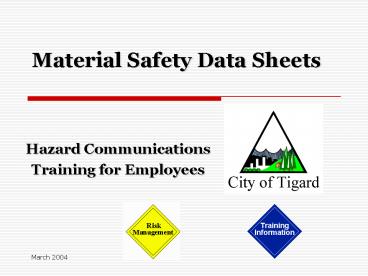Material Safety Data Sheets PowerPoint PPT Presentation
1 / 14
Title: Material Safety Data Sheets
1
Material Safety Data Sheets
- Hazard Communications
- Training for Employees
2
Hazardous Communication Program Procedures
Effective 11/20/00
- This procedure is established to
- ensure compliance with the applicable state and
federal standard - safeguard the health and safety of employees and
the public and - establish guidelines to follow for implementation
and maintenance of a hazard communication
program. - Material Safety Data Sheets (MSDS) shall be
readily available for all flammable, toxic and
caustic materials utilized within City
facilities.
3
DEFINITIONS
- Flammable A substance having a flash point
below 100 degrees Fahrenheit - easily ignited and
quick burning. - Toxic A substance which has the capacity,
through chemical reaction or mixture, to produce
injury or harm to the body by entry through
absorption, ingestion, inhalation, or injection. - Caustic A substance with the capability of
burning, destroying or eating away organic tissue
by chemical reaction - Corrosive.
4
MATERIAL SAFETY DATA SHEETS (MSDS)
- The MSDS is used by chemical manufacturers and
vendors to convey hazard information to users. - MSDS should be obtained when a chemical is
purchased. - A chemical inventory list, and MSDS, for each
chemical are maintained in a database in
binders.
5
READING THE MSDSInformation on the MSDS is
organized in 16 sections as follows
- Identity The chemical name, trade name and
manufacturers name, address and emergency phone
number can be found here. - Hazardous Ingredients Hazardous ingredients are
identified here. - Physical and Chemical Characteristics,
Boiling/Melting point, vapor pressure and
density, water solubility, and appearance/odor
can be found here. - Fire Data Flash point, flammable limits,
extinguishing media, unusual fire/explosion
hazards, and any special fire fighting equipment
are listed here.
6
Reading the MSDS, Continued
- Health Data Routes of entry (inhalation,
ingestion, etc), effects from short and long
term exposure, emergency and first aid procedures
fall in this section. - Reactivity Data Stability, incompatible
materials, hazardous decomposition are among the
topics in this area. - Spill or Leak Procedures You will find clean-up
procedures, waste disposal, and precautions
needed when handling/storing materials here. - Spill Precaution Information Any personal
protective equipment (PPE), ventilation, and
work/hygiene practices are noted here.
7
Reading the MSDS, Continued
- Physical and Chemical Properties This section
will include information about the physical and
chemical properties of the material. The
following characteristics should be detailed
appearance, odor, physical state, pH, vapor
pressure, vapor density, boiling point,
freezing/melting point, solubility in water and
specific - Stability and Reactivity This section requires
that potentially hazardous chemical reactions be
identified. It addresses chemical stability,
conditions to avoid, incompatibility with other
materials, hazardous decomposition and hazardous
polymerization.
8
Reading the MSDS, Continued
- Toxicological Information This section discusses
data used to determine the hazards that are given
in Section 3, "Hazard Identification." The
following information can be addressed acute
data, carcinogenicity, reproductive effects,
target organ effects, etc. - Reactivity Data Stability, incompatible
materials, hazardous decomposition are among the
topics in this area. - Disposal Considerations This section gives
important information that may be helpful in the
proper disposal of the material. The information
can cover disposal, recycling and reclamation.
9
Reading the MSDS, Continued
- Transport Information This section is designed
to give basic shipping information. The basic
shipping information could include the hazardous
materials description, hazard class and the
identification number (UN or NA numbers). - Regulatory Information This section discusses
information on the regulations under which the
material falls. Examples of a few regulatory
agencies are OSHA, TSCA (Toxic Substance Control
Act), CERCLA (Comprehensive Environmental
Response, Compensation, and Liability Act), SARA
Title III (Superfund Amendments and
Reauthorization Act).
10
Reading the MSDS, Continued
- Other Information This section should
include any other important information
concerning the material. This information can
include hazard ratings, preparation and
revisions of the MSDS, and label information.
11
Fire Hazard - Red4 Flash Point below 73 F
(Boiling Point below 100 F)3 Flash Point below
73 F 2 Flash Point above 100 F, not exceeding
200 F1 Flash Point above 200 F0 Will not burn
Reactivity (Instability) - Yellow4 May
detonate3 Shock and heat may detonate2 Violent
chemical change1 Unstable if heated0 Stable
Health Hazard - Blue4 Deadly3 Extreme Danger2
Hazardous1 Slightly Hazardous0 Normal Material
Specific Hazard - WhiteOX or OXY OxidizerW
(with line through it) Use no water
higher numbers higher hazard
GASOLINE
12
Protecting Yourself
Personal Protective Equipment (PPE) may be needed
to protect yourself from chemical hazards Use
the proper PPE required for each chemical Check
the PPE before use to make sure it is not damaged
Chemicals can be safely used if
You know the hazards and how to protect
yourself They are used only for approved
purposes They are stored properly
13
REVIEW
- Know what you are working with
- Know where MSDS are located and how to use them
- Ask your Supervisor or Safety Committee Rep. if
you have questions - Only trained employees may use chemicals
- If you have not used an item in 6 months, you
must re-read the MSDS and understand it.
14
The End
Read the MSDS to use hazardous material safely.

